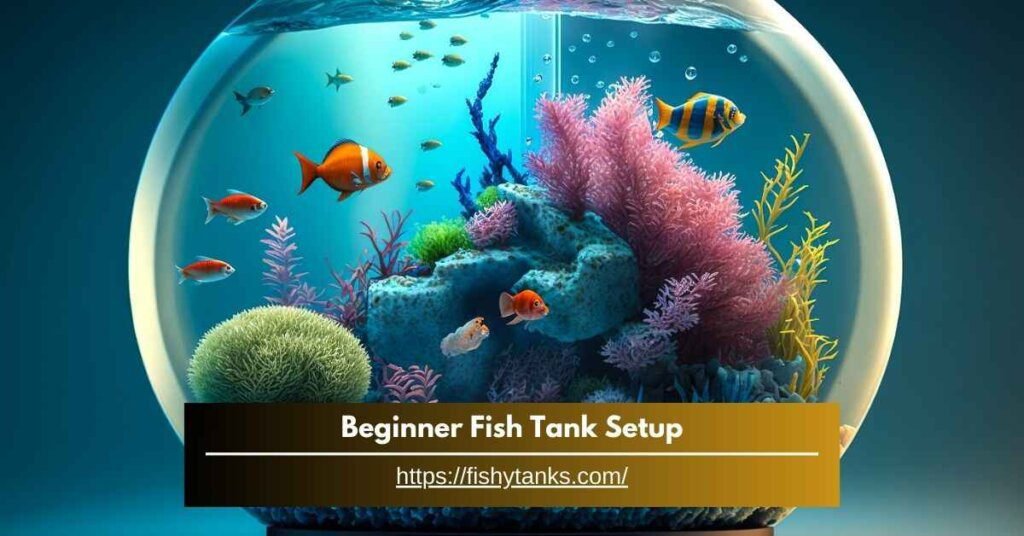Welcome to the world of fish tanks. Fish tank setup for beginners can be a fun hobby. But it can be quite confusing especially if you’re new to it. Don’t worry, we’re here to help. We will show you how to set up your first tank, step by step. You will learn what equipment you need, how to choose the right fish, and how to keep them healthy. We’ll also teach you how to keep the water clean and fix any problems that might come up. By the end of this guide, you will be ready to start your aquarium. Set up a fish tank for beginners is easier than you think. With a little help, you can create a beautiful home for your fish. Alright, let us begin and try it gradually, step by step. Soon, you’ll be enjoying your very own aquarium.
Equipment Needed For Setup a Fish Tank as a Beginner
1. Fish Tank: The size and type of tank you need will depend on the space you have available and the type of fish you want to keep.
2. Gravel or Substrate: This is the material that lines the bottom of the tank.
3. Decorations: These can include plants, rocks, and ornaments to create hiding places and visual interest.
4. Filter: This device helps to keep the water clean and clear by removing waste and excess food.
5. Heater: If you plan to keep tropical fish, you’ll need a heater to maintain a warm water temperature.
6. Thermometer: This is used to monitor the water temperature.
7. Lighting: You will need a light source to illuminate the tank and promote plant growth.
8. Food and Water Treatments: You will need food for your fish, as well as treatments to remove chlorine and chloramines from the water.
9. Water Test Kit: This is used to monitor the water quality and make adjustments as needed.
10. Fish Net: A soft-mesh net is used to catch and handle your fish.
11. Cover or Lid: This helps to prevent fish from jumping out and reduces evaporation.
12. Power Strip: This is used to plug in your tank equipment and protect against power surges.
Perfect Size of a Fish Tank Setup for a Beginner
When you are new to fish tanks, it is important to choose the right size. Small tanks (less than 10 gallons) are great for small areas and good for tiny fish like guppies or betta fish.
Medium tanks (10-20 gallons) are perfect for small rooms and work well for small groups of fish. Large tanks (over 20 gallons) are best for big spaces and bigger fish.
But, if you are just starting out, it’s best to start small. Small tanks are easier to take care of and cost less to set up.
You can learn the basics of fish tank care without feeling overwhelmed. A 10-gallon tank is a good size for starters and those who want a basic setup without the added complication of numerous fish. It is big enough for a few fish and some decorations, and it’s easy to move around.
Best Fish for a New Fish Tank?
The best fish for a new tank depends on several factors, including the tank size, water type, and your personal preferences. However, here are some popular and easy-to-care-for fish that are perfect for beginners:
1. Guppies: Colorful, peaceful, and easy to care for.
2. Neon Tetras: Small, schooling fish that are very active and fun to watch.
3. Goldfish: A classic choice, goldfish are relatively easy to care for and can thrive in a well-maintained tank.
4. Betta Fish: Also known as Siamese fighting fish, betta fish are popular for their elaborate fins and vibrant colors.
5. Cory Catfish: Small, armored catfish that are great for cleaning up food debris.
6. Harlequin Rasboras: Peaceful, active fish that are easy to care for.
7. Zebra Danios: Hardy, active fish that are easy to care for and breed.
8. Platies: Another popular choice, platies are easy to care for and come in a variety of colors.
How Many Fish should Beginner have in New Fish Tank?
Start with just a few fish when you’re new to fish tanks. This way, you can learn how to take care of them without feeling overwhelmed.
A good rule is to have 1-2 inches of fish for every gallon of water. Small tanks are okay for 2-5 fish, medium tanks can handle 5-10, and large tanks can have 10-15.
But, you need to consider the size and type of fish, too. Bigger fish need more space and food, so you might want fewer of them.
Some fish like to be in groups, while others like to be alone. It’s always best to start with a few fish and add more later.
If you put too many fish in the tank, it can get dirty and stressful for them. Make sure to research what your fish needs and ask a pet store expert if you’re unsure.
Step-By-Step Process to Setup Fish Tank as a Beginner
Fish tank setup for beginners can be fun, but it can also be confusing if you are new to it. With some help, you can make a great home for your fish and enjoy having them as pets.
Here are some simple steps below:
Step 1: Choose the Right Tank
Choose a tank that is appropriate for your space and the number of fish you want to keep. First, think about the size, the shape, and the material of the tank.
Step 2: Set Up the Tank
Place the tank in a stable and level location. Add gravel or substrate to the bottom of the tank. Install any decorations or plants.
Step 3: Install the Filter and Heater
This filter should be selected based on the size of the aquarium in your home. For proper installation of the filter, you should follow the installation guide provided by the manufacturer. Install a heater if you plan to keep tropical fish.
Step 4: Add Water
Always treat the water by using a water conditioner to get rid of chlorine and chloramine. Fill the tank with water that is the appropriate temperature for your fish.
Step 5: Cycle the Tank
Allow the tank to cycle for 2-4 weeks before adding fish. Keep an eye on the water parameters and change the water chemistry.
Step 6: Add Fish
Choose fish that are appropriate for your tank size and water parameters. Acclimate the fish to the tank water before releasing them. Start with a few fish and gradually add more.
Step 7: Maintain the Tank
You should also check the water parameters and adjust as required, at least once a week. Perform partial water changes weekly. Clean the gravel and decorations regularly.
Regular Maintenance Tasks for a Healthy Tank
- Change 10-20% of tank water weekly
- Vacuum gravel to remove debris
- Clean/replace filter media as needed
- Test water for ammonia, nitrite, nitrate, pH, etc.
- Control algae growth
- Monitor fish for stress/disease
- Clean tank glass/decorations
- Add water conditioner
- Check water temperature
Last Words
Setting up a fish tank as a beginner is fun and easy when you follow these steps. Beginners can set up a fish tank and make a happy home for their fish by choosing the right tank, setting it up correctly, and keeping it clean. Don’t forget to check the water, clean the gravel, and keep algae under control. Your fish will be happy and healthy if you take good care of them. Don’t worry if you are new to this – start small and learn as you go. Ask for help if you need it, and soon you will be a pro at taking care of your fish tank.
FAQ’s
Q1: What size tank should I get for my first fish tank?
A 10-20 gallon tank is a good size for beginners, as it’s easy to maintain and can hold a few fish.
Q2: How often should I change the water in my tank?
Change 10-20% of the tank water weekly to keep the water fresh and clean for your fish.
Q3: What kind of fish should I get for my tank?
Choose hardy, beginner-friendly fish like guppies, neon tetras, or goldfish that are easy to care for.
Q4: How long does it take to set up a fish tank?
It usually takes a few hours to set up a fish tank, including setting up the tank, installing equipment, and adding water and fish.
Also Must Read More: 7 Best Fish Tank Setup Ideas for Small Aquariums



